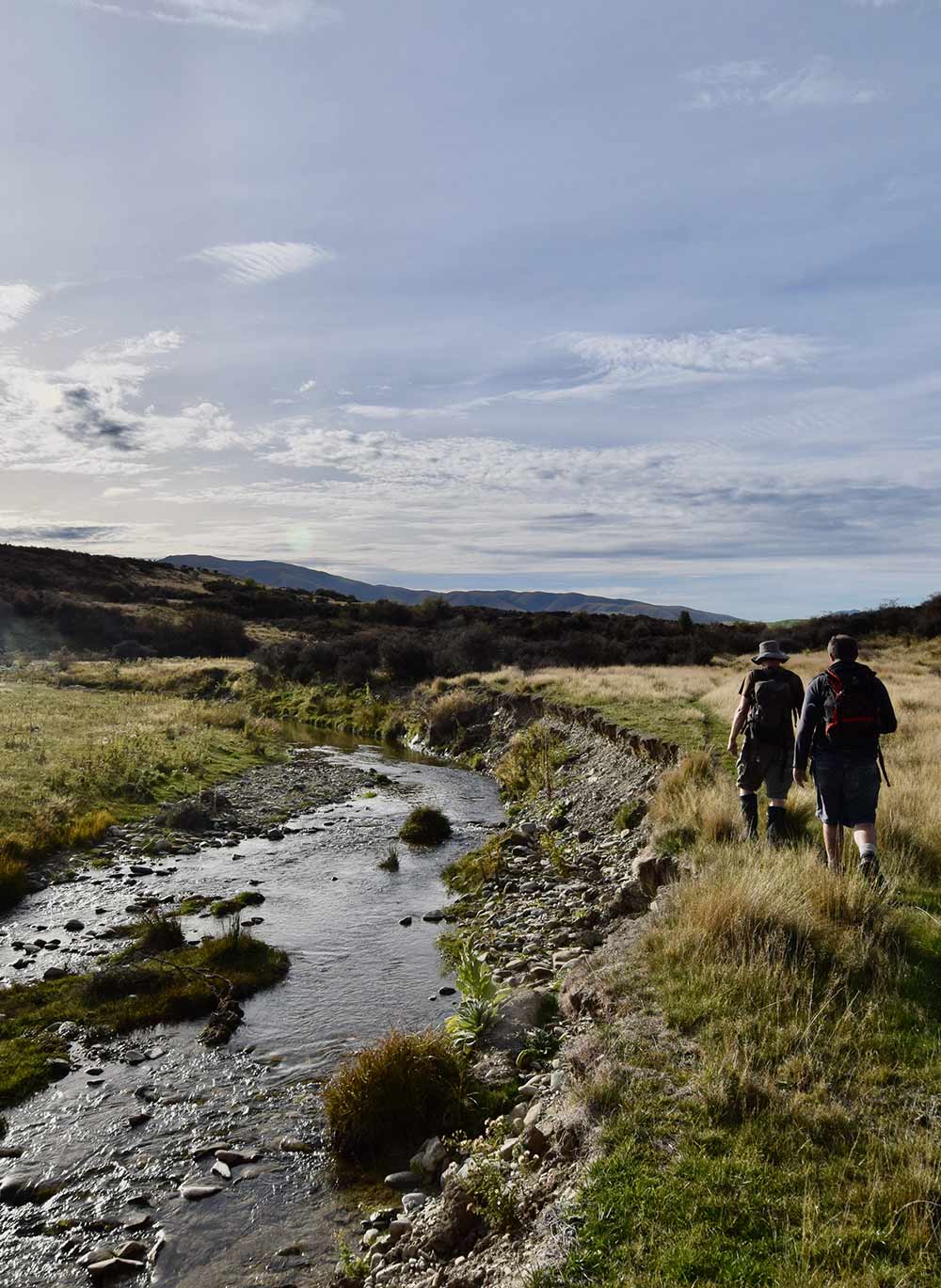
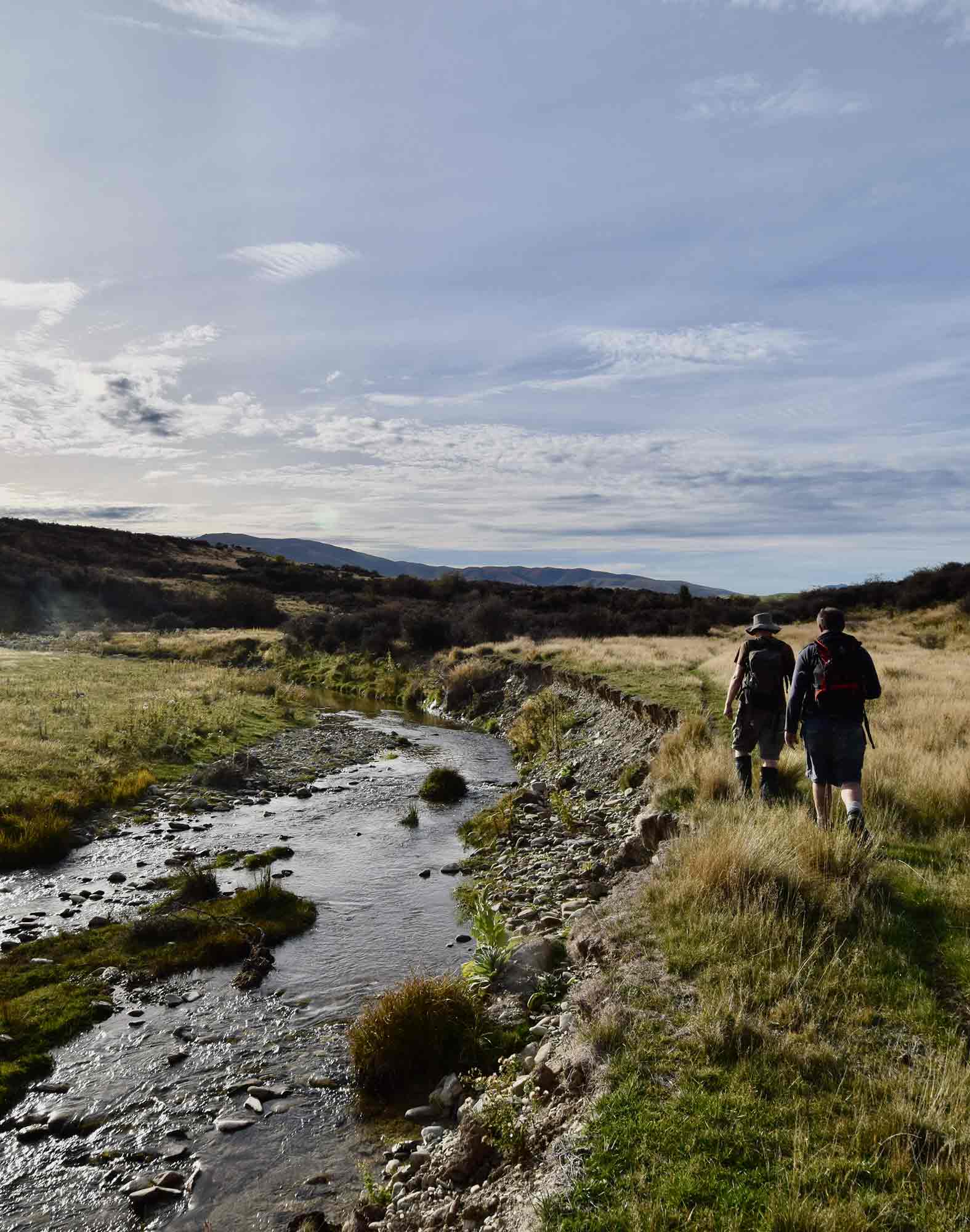
Bone Hunters: The ancient lake revealing New Zealand’s mysterious past
Beneath famously dry Central Otago are the remains of an enormous, ancient subtropical lake that was once home to crocodilians, turtles, giant parrots, bipedal vampire bats and palm trees. The kilometre-thick layer of lake bed is helping to unravel the mystery of our bizarre land of birds.
By George Driver
Te Papa curator of vertebrates Alan Tennyson and researcher Jonathan West on a fossil hunt at Mata Creek, near St Bathans.
As I drove down a dirt road beneath the Hawkdun Range in Central Otago, the rising sun began turning the range’s kilometre-high tussock face into soft contours of gold and purple. Snow flecked the shadows from a recent southerly front. I had to resist the urge to keep driving until the road gave out. This wasn’t the landscape I’d come for.
After turning off through a farm gate and inadvertently shepherding a paddock of grazing merinos with my car, I parked and scrambled to the bottom of a gully. There a small creek had eroded a three-metre face, revealing a thin layer of gluggy grey clay at the bottom. This was it.
In the muddy slop, a few kilometres from St Bathans, five university students were face down and excavating, looking like Anzacs digging in before a barrage in the Somme. But these diggers in the desert weren’t looking for safety from shrapnel, but for a 16-million-year-old subtropical lake.
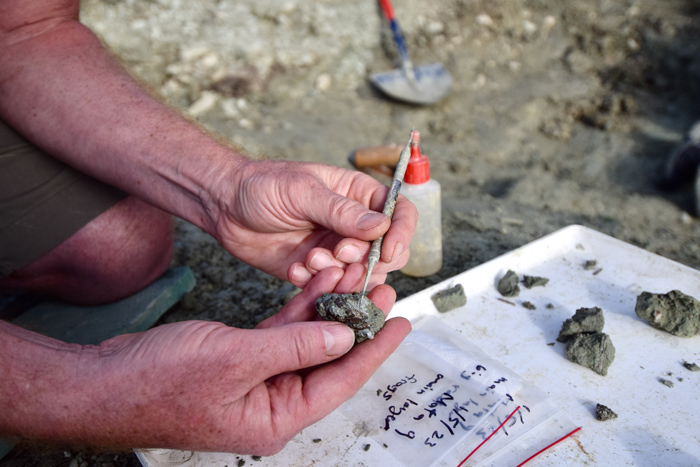
The skull of a 16-million-year-old duck. All photos unless otherwise credited: George Driver
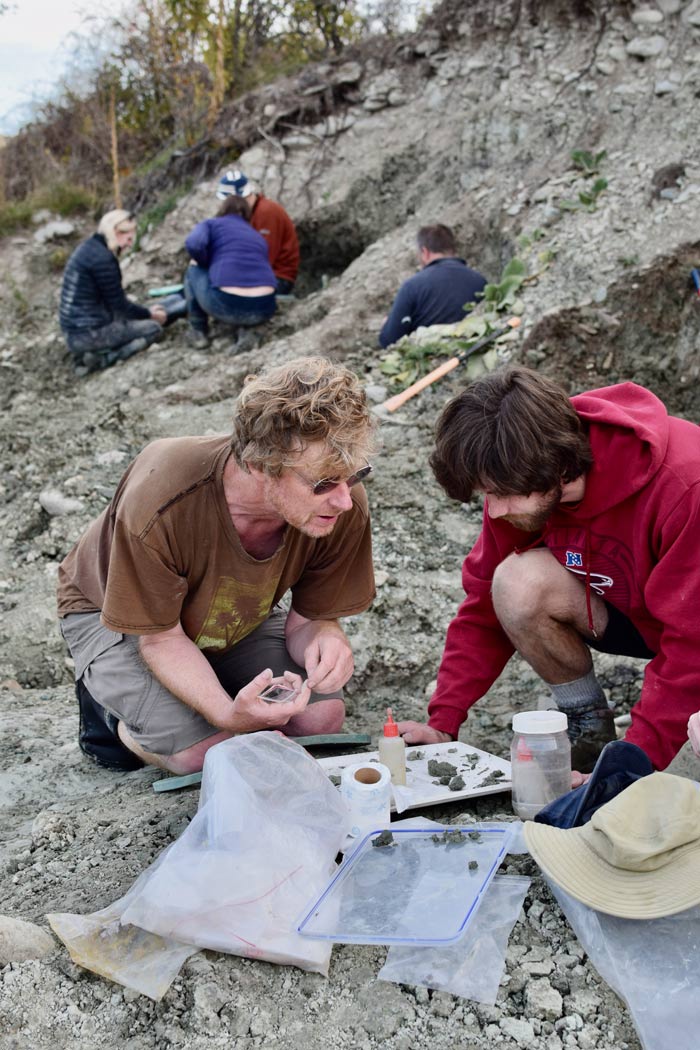
Alan Tennyson works with a University of Otago student to label fossils uncovered at Mata Creek.
It wasn’t long before someone found a bone. Alan Tennyson, Te Papa’s curator of vertebrates, has been coming to this creek for the last 22 years. As the students scraped out tiny body parts, Tennyson stood back, ready to identify the emerging fragments from species that no longer exist. “This is the tibiotarsus of a juvenile anatid,” Tennyson confidently declared, as a student brought forth a 5cm-long shard of bone from the leg of an extinct duck. It was placed in a labelled ziplock bag, as were the rest of the morning’s discoveries – a mixture of other duck and fish remains – to be analysed in detail in the lab, compared with other known species, and added to the jumbled jigsaw of New Zealand’s mysterious prehistory.
It didn’t look like much, but before researchers began excavating the sediment of this ancient lake, this small pile of bones would have likely exceeded the entire extent of terrestrial fossil bones found in New Zealand from between 100,000 years ago and 70 million years ago. For more than a century, this absence of fossils left a question mark over how and why our land of strange birds evolved. Theories have been floated, but without rock-hard evidence. The origins of our fauna and flora, Tennyson says, had been an educated best guess.
But since the fossils near St Bathans have started to be unearthed, we’re getting the first detailed snapshots of this period of our ancient past. And it’s not in just one or two rough polaroids, but tens of thousands of remains from the Miocene (an epoch spanning 23 million to 5 million years ago), showing life then in a resolution that no one dreamed of. It’s literally changing our understanding of what it means to be a kiwi.
Drowned or castaway?
Life in New Zealand is a bit weird. It’s world famous for being devoid of terrestrial (land-dwelling) mammals, except a couple of bats, instead boasting an ecosystem dominated by birds, and some strange birds at that. Rather than hoofed ruminants, like cows and sheep, New Zealand had plump, flightless avian grazers – the takahē, kiwi, moa; even a flightless and nocturnal parrot, the kākāpō. In place of large mammalian predators, we had the largest known eagle, Haast’s eagle.
Much of this strangeness has been attributed to our isolation. New Zealand – or more accurately, the continent of Zealandia – was once part of the ancient supercontinent, Gondwana, fused to South America, Africa, India and Antarctica. But about 83 million years ago, Zealandia began to break off from Australia, finally settling about 4000km away roughly 60 million years ago. It’s been a long-held theory that our unusual flora and fauna are ancient relics from Gondwana that hitched a ride before Zealandia drifted into the Pacific Ocean (sometimes dubbed the “Moa’s Ark” theory), later supplemented by arrivals blown over from Australia.
In the 1990s, an alternative theory was proposed, popularised by GNS scientist Hamish Campbell, that New Zealand actually slipped entirely into the sea about 25 million years ago in an event called the Oligocene Drowning. Campbell believed the continent was probably submerged for two millions years, wiping out everything that was here. Therefore our flora and fauna would be entirely derived from species being blown or drifting over from Australia on the prevailing westerly. “Our continental crust thinned out,” Tennyson says. “This meant it began to slowly sink until the plate boundary between Pacific and Australian plates became more active about 23 million years ago and started pushing the land back up.”
“We have a fantastic record of modern fauna before humans arrived, but almost nothing on an evolutionary time scale.”
Proponents of the drowning theory argued that there just wasn’t much evidence that there were land-dwellers here for almost our entire history. We have a lot of bones from birds, bats and lizards that have been preserved in caves and swamps over the last 100,000 years, Tennyson says. But these are the same animals that were here when humans first arrived. They don’t provide any information on how these species evolved or arrived. On the other hand, the country has a lot of marine fossils and rocks, so much of it must have been underwater at some point.
“Our terrestrial vertebrate fossil fauna is pathetic on a global scale,” Tennyson says. “We have a fantastic record of modern fauna before humans arrived, but almost nothing on an evolutionary time scale. There are deposits scattered around the country of multi- million-year-old fossils, but they’re almost all marine species, like penguins, sea birds and whales.”
There have been a handful of terrestrial fossil discoveries, the most dramatic found by amateur palaeontologist Joan Wiffen in the 1970s. She discovered an enormous tailbone from a theropod – a large Tyrannosaurus rex-like predator – in a stream in Hawke’s Bay. Her work revealed that a number of land- dwelling dinosaurs were here about 75 million years ago, but there was little else in the terrestrial fossil record. It left a yawning gap in our knowledge.
This absence is partly because New Zealand is one of the most geologically active places in the world. The sedimentary rocks that would have entombed the bones of past animals have either been blasted away or buried by magma and ash from volcanoes, scraped away during the last ice age when an ice cap covered much of the central South Island, or eroded from the hills and mountains thrust up by tectonic collisions. It hasn’t left much behind, except marine fossils that were captured in the sediment on the seafloor before being thrust up to form New Zealand. Or is it simply that there wasn’t any land above water in Zealandia for animals to roam?
The fossil-fuel find
In the 1970s, Barry Douglas was looking for coal when he found something much more interesting. Douglas was working for the University of Otago geology department when he got a government contract to look for lignite in Central Otago. For eight years he walked just about every valley in the region, often living in a tent through the harsh winters. “It was marvellous,” Douglas recalls, “despite the harsh climate.”
He found pockets of coal scattered around, which had been known about since the gold rush in the 1860s. But he soon realised the lignite was all in the same chalky stratified layer of sedimentary rock. From Naseby to Albert Town, Cromwell to the Lindis Pass, Roxburgh to the Waitaki Valley, even two kilometres high up the Pisa Range, there was what appeared to be an ancient lake bed. It had left a rock record up to a kilometre deep, and at least 5600 square kilometres in area, evidence of a lake almost 10 times the size of Lake Taupo, but possibly much larger. In the late 1970s, he named this “Lake Manuherikia”, probably the largest lake Zealandia has ever known.
Then he began to find bones. In 1979, he found a bird bone in chalky white clay, not far from St Bathans – a rare terrestrial fossil. Douglas completed a PhD on his discovery in 1986, but he says it gained little attention. “It just sat on a shelf at the university.”
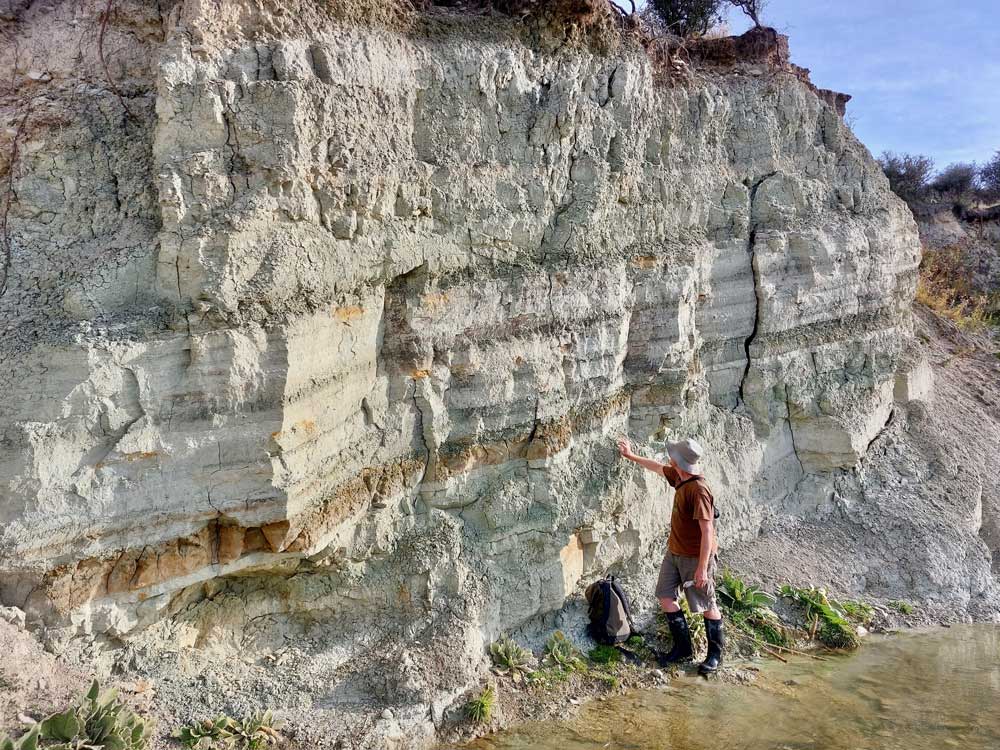
Eroded cliff faces beside Mata Creek reveal stratified layers of sediment left by the ancient Lake Manuherikia, which can be hundreds of metres deep.
One person who took note, however, was Mike Pole, who Douglas met while Pole was studying geology and biology at Otago. Pole had known the fossils of the region since childhood. He grew up in Alexandra and had been finding fossilised plants during family picnics at Bannockburn since he was 11, and became hooked.
Pole continued to focus on plant fossils at university – something he says almost no one was looking at at the time. “Plant fossils were like a black hole,” he says. “To most people they were just leaves and no one really had any interest in them.” But Pole realised that plants were a marker of climate and biodiversity. Around Bannockburn and St Bathans, he began to uncover what he calls “one of the most biodiverse plant-fossil localities on the planet”. The flora and fauna of the lake began to take shape.
Some of the leaves had been preserved down to the cellular level, enabling Pole to identify more than 100 plant species. “If you process it correctly you can actually get the whole leaf out of the rock and hold it up and see the sun shining through it and you’ve got all of the cellular details which can tell you exactly, for example, what genus of fossil conifer it is. That was a game-changer.”
Pole and Douglas continued to research the rocks of the ancient lake in their spare time while working as geology contractors, and wrote a number of papers together, but their work garnered little interest. Then Pole found a big bone. In 1989, he was walking along Mata Creek – that site near St Bathans – looking for fossils. As the sun began to set he saw a bone about 7cm long sticking out of an outcrop. “I thought, ‘Shit, that looks bigger than a fish.’”
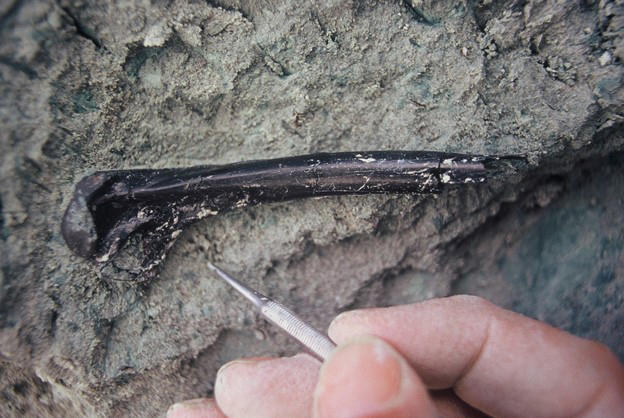
Excavating the fragments of bone fossils can be delicate work, sometimes requiring dental tools to carefully scrape away sediment. Photo: Canterbury Museum
Pole took the bone to palaeontologist, Ralph Molnar in Australia (who had earlier identified Joan Wiffen’s dinosaurs), who said it was clearly from a crocodile, probably about three metres long. The land of birds now had a large reptile. The pair published a paper on the find in 1997 and, slowly, a new picture of the life in New Zealand’s past began to emerge.
Unravelling the mystery
When Alan Tennyson began searching for fossils at St Bathans in 2001, he had no inkling that it would come to be considered the most important site for animal fossils in the country. At the time, Tennyson was five years into a new job as bird collection manager at Te Papa. With what he says was the energy of a “newbie”, he turned his attention to the gap in the collection’s terrestrial fossil record, working with renowned moa expert, Trevor Worthy. The pair set about investigating sites where terrestrial fossils had been reported – then just a handful of places – and found little, before they decided to visit St Bathans. While en route, they attended a conference in Kaikoura, where they met an Australian academic,
Jim McNamara, who happened to have just come from St Bathans where he’d been on an exploratory dig looking for mammal fossils. “He said ‘I’ve just found all of these bird bones at St Bathans,’” Tennyson recalls. “We were like, ‘Whoa, what!’”
After getting tips from Douglas and Pole, Tennyson and Worthy, along with Craig Jones from GNS Science, went for a dig. Within days they’d unearthed more terrestrial fossils than had ever been discovered in this country. “We were astonished,” Tennyson says. “We found an unbelievable number of bones. Before we came down here we would have been excited if we’d found one bone. We ended up with handfuls of these things.”
They soon realised they needed help. New Zealand doesn’t have many fossil experts, particularly not for the likes of crocodiles, and a collaboration began with the University of Adelaide, the University of New South Wales and Canterbury Museum; and later, Flinders University, the University of Queensland and the University of Otago. This project has continued for the last 22 years, much of it actually funded by the Australian government.
““The excavations range from finely scraping at the sediment using dental tools to carefully reveal shards of bones, through to excavating using heavy machinery and sifting tonnes of material to reveal tens of thousands of tiny fossils.”
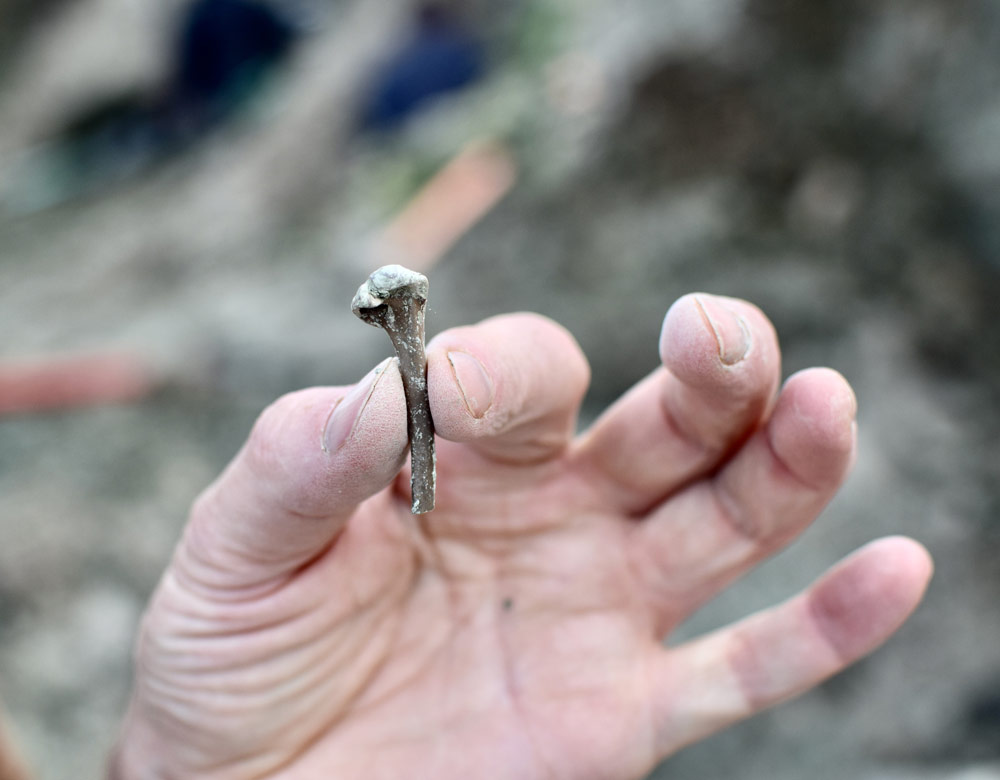
Fossil bones uncovered near St Bathans are almost always broken and fragmented, which can make identifying different species challenging.
The excavations range from finely scraping at the sediment using dental tools to carefully reveal shards of bones, through to excavating using heavy machinery and sifting tonnes of material to reveal tens of thousands of tiny fossils. “We’ve now got thousands of bird bones and millions of fish bones,” Tennyson says.
The fossils have all been mixed up over the millenia, so the specimens are almost never intact. Mostly, bone fragments are found jumbled together, making identification challenging. But researchers have found at least 45 bird species, four species of lizard, five bat species, 17 fish species, and two frog species, although many haven’t yet been formally named and described.
Many are familiar: ducks, rails, parrots, songbirds, pigeons, lizards, tuatara and bats. The kind of stuff you’d expect to find. Then there’s more tropical species: a large turtle, crocodilians and a flamingo-like bird. When they lived, Central Otago was more like southern Queensland. The area was about 7°C warmer due to naturally high levels of atmospheric carbon during a period called the Miocene Climatic Optimum. The North Island then was mostly underwater.
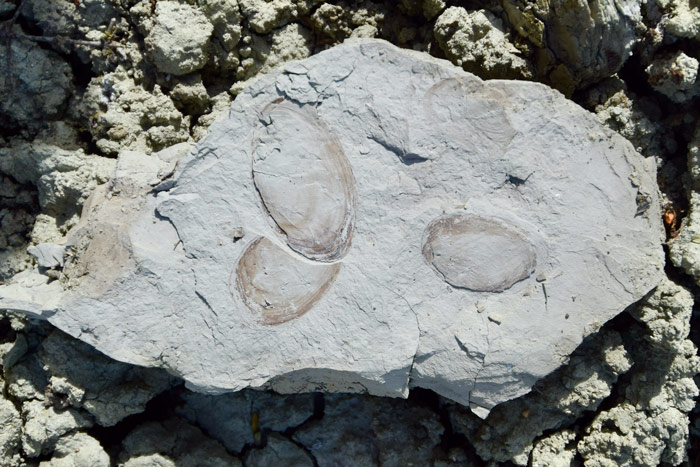
Thousands of freshwater mussels have been preserved from Lake Manuherikia, with some in slate-like rock providing an almost-photographic image of life in the lake.
Then there are the weird species. There was a flightless and possibly carnivorous parrot, dubbed “Squawkzilla”, that was a metre tall, and bipedal burrowing bat. “It’s like you’ve fallen down the rabbit hole into Alice in Wonderland,” says Nic Rawlence, director of the University of Otago’s paleogenetics laboratory. “You’ve got the familiar, but then you’ve got the weird as well.”
It also appears to have a greater diversity of plants, bats and birds than in modern times. “What’s really amazing is the diversity of plant and animal fossils is huge,” Tennyson says. “We can reconstruct the whole ecosystem virtually, and it’s a really rich area.”
The landscape was also different. Rather than mountainous, the area was probably mostly low-lying. All of the mountains of Central Otago came up much later, rising up through the remains of the lake bed and sending the sediments of Lake Manuherikia into a jumble throughout the region. Some have remained marooned on mountain tops. Part of the country that’s often blanketed in snow in winter and is today largely devoid of trees was then filled with palms, eucalypts and casuarinas, as well as beech, flax and other contemporary species
Bones of contention
Tracing the evolution of these species to modern flora and fauna isn’t straightforward, however. Many of the bird fossils are very similar to existing species, but closer analysis has found that some of our modern birds are actually more closely related to birds found in Australia today. This suggests that some of the Manuherikia species died out and modern birds evolved from later invasions from Australia. It’s also shown that flightlessness has evolved independently here multiple times. “We’re seeing a pattern over millions of years of animals coming over, evolving, dying out and that happening again and again,” Tennyson says.
Which brings us to the ancient relatives of moa and kiwi. It’s long been debated whether they existed when Zealandia split from Gondwana, or evolved from more recent arrivals that flew over. St Bathans is providing answers. “We’ve found what looks like moa egg shell,” Tennyson says. “This suggests there were big moa here then, so it’s proof that moa were not flying around as little things. On the flipside, kiwi bones from here suggest they were so small that they might have been able to fly at that time. It’s all theoretical, but it’s new information that you can’t find from genetic analysis. And these are world-famous birds.”
Canterbury Museum senior curator Paul Scofield, who has been involved with the project since 2002, says St Bathans shows our flora and fauna have been much more dynamic than first thought. “People had this idea that New Zealand was the relictual place where nothing had happened for 60 million years after we separated from Gondwana, but it’s exactly the opposite,” Scofield says. “There have been far more extinctions here than Australia because our land is so dynamic, going up and down, and species have come and gone.”
The presence of such a diverse range of species also provides further evidence that Zealandia wasn’t completely submerged in the Oligocene. Some species, like tuatara and freshwater mussels, couldn’t have survived the trip from Australia. “We may have lost 80 to 90 percent of Zealandia underwater, but there was enough left that all of the major lineages of animals here survived,” Rawlence says.
A kiwi mammal?
Then there’s the mammal. In the early 2000s, Tennyson and the team found three tiny bones that didn’t look like birds, lizards or fish. The bones included two jaw bones and part of a femur, all only about half a centimetre long. They were sent to fossil vertebrate expert Mike Archer and bat expert Suzanne Hand, both from the University of New South Wales (New Zealand doesn’t have many mammal fossil experts, for obvious reasons). Archer and Hand believe the bones are from a mouse-sized mammal unlike anything else that’s been discovered before. It doesn’t fit into the main animal groups – placentals, marsupials or monotremes (like platypus and echidna) – but appears to be a “ghost lineage”, a kind of relic from the early evolution of mammals.
When the discovery was published in 2006, Tennyson said the animal – nicknamed the waddling mouse – “ranks up there with the discovery of the first moa bones, the first dinosaur bones in New Zealand”. The mammal-less land of birds was apparently mammal-less no more.
It was expected that more discoveries of this ghost lineage would turn up, but progress has been slow.
Some have become sceptical that the bones really are from an ancient terrestrial mammal. “New Zealand has weird bats and there is a good possibility that the waddling mouse bones are just those of a weird bat,” Rawlence says. “When you get bats doing weird things, the bones start looking like other things, so weird bat bones may start looking like primitive mammals.”
However, Mike Archer says recently discovered “key bits” have made it clear that these terrestrial mammals were just that, not bats. “We’re still not quite ready to produce the next paper about these,” Archer says. “Hopefully later this year that situation will change.”
Scofield’s also a believer in the waddling mouse. “We still don’t know exactly what the waddling mouse is, but it’s not a bat. There are a couple of teeth which haven’t been published which we’ve collected over the last couple of years that tell us it’s not a bat. People who know about these things know it’s not a bat, but exactly what it is and what it’s related to is still up in the air.”
One background issue is that Canterbury Museum and Australian researchers have split off from those from Otago and Te Papa: the groups now work independently.
If there were mammals, it poses many more questions. Why didn’t they play a larger role in the ecosystem, as they have almost everywhere else? On the other hand, it’s not clear why New Zealand would be devoid of mammals when mammals existed on Gondwana.
Scofield suggests the mammals may not have been able to survive the ice ages, which began about 2.5 million years ago. “Monotreme mammals like the echidna, reliant on egg laying, are very intolerant of dramatic temperature fluctuations.”
Other questions remain. It’s still not certain exactly when the St Bathans fauna existed. It is commonly said to cover the period from 19 million years to 16 millions years ago, but it has been hard to date. Mike Pole believes the rock layer may record a much longer period, possibly from about 20 million years ago, to 12 million years ago or less.
The breadth of time recorded is important, for the fossils record dramatic climate change. The planet cooled significantly during the Miocene, and that dramatically affected the species. Palm forests, for example, began to disappear later in the fossil record, as the climate cooled, Pole says. “There are several distinct vegetation types in the fossil record, which clearly relates to climate change,” Pole says. “There’s nowhere else in the world that records that kind of complete change in vegetation over that geological thickness in the Miocene.”
It’s likely this cooling, along with the later ice ages, were what drove much of the tropical flora and fauna to extinction. Understanding how the animals of ancient St Bathans responded to this cooling will likely take decades of more digging.
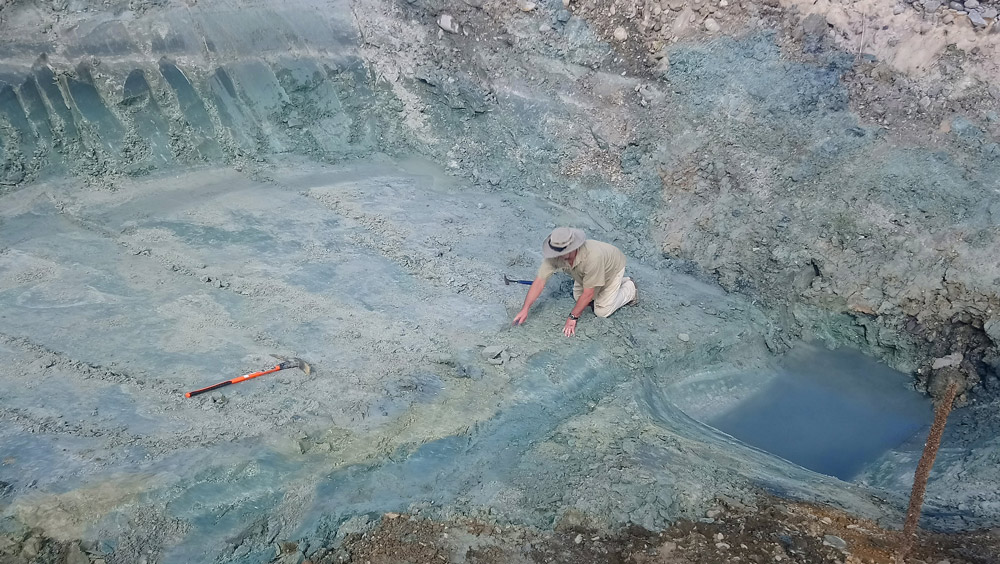
Photo: Canterbury Museum
After lunch, Tennyson takes me on a walk down Mata Creek, where we find many more layers of ancient lake bed being revealed by seasonal floods. One outcrop has dozens of mussel shell fossils in slate- like layers. A well-preserved fragment finds its way into my satchel. Around a bend there are soccer ball- sized stromatolite fossils. These coral-like formations are believed to be Earth’s oldest living life-forms. Now a few golf ball-sized stromatolites that grew in the waters of this ancient lake sit on my mantelpiece.
Tennyson describes what it’s like for a researcher working in the place these were found. “You’re discovering things that haven’t been seen by any humans ever,” he says. “You’re the first person to see it and you never know what you’re going to get. It’s very much a treasure hunt.”
George Driver is North & South’s Southern correspondent, a role made possible by NZ On Air’s Public Interest Journalism.

This story appeared in the July 2023 issue of North & South.

